Treating MS with Compassion and Science
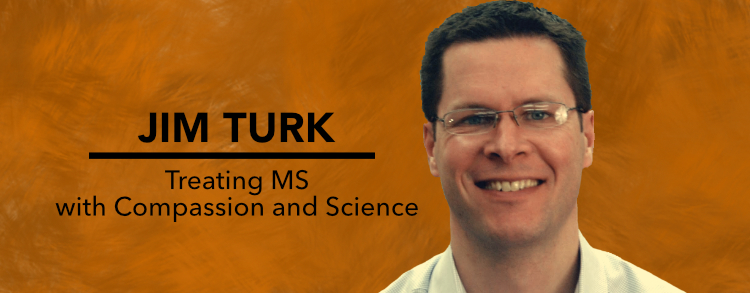
Here’s a profile I wrote for the Congressionally Directed Medical Research Program. I was part of a group that reviewed research grant applications back in December and they wanted to do a profile on me. https://cdmrp.army.mil
And here’s the article:

I was always a give-it-everything-you’ve-got and burn-the-candle-at-both-ends kind of guy. I was running marathons, playing in a band, working full time, going to graduate school earning a master’s degree in biotechnology, and keeping up with my duties as a husband and father of two boys when I couldn’t ignore my symptoms anymore. I had, after all, been misdiagnosed a few times and didn’t want to look like a hypochondriac. But, collapsing while coaching my son’s tee-ball team was the final straw.
I talked to my doctor and after briefly exploring the possibility of a cardiovascular problem, I had an MRI and it was confirmed that I had lesions on my brain that were consistent with Multiple Sclerosis.
How could that be, I wondered. A guy that seemed in great shape, climbing the ladder of success, and only 37 years old?
After the requisite period of panic, I enrolled in a clinical trial. In my career, I was heavy into research so it seemed logical. By coincidence, my neurologist was looking for volunteers for a clinical trial.
The trial was pretty unconventional ‒ it involved my swallowing parasite eggs! In the past, I had always been advocating for research and figured that people might not want to volunteer for something that sounded so gruesome, so I figured it was time to put up or shut up.
I decided early on that I would use my research background and natural rapport by spreading the word about clinical trials. About how important enrollment is, even when the treatment doesn’t work. I’d had a lot of experience in clinical research through my work, as well as graduate school, and now I had the perfect icebreaker!
I contacted the MS Society and started traveling around to different support groups delivering my message. Then the Wisconsin chapter of the MS Society asked me to teach a class on the subject at an “MS Summit.”
I became more involved with the MS Society and was soon doing news pieces for MS events. I was also getting a lot of press for the clinical trial. This included BBC Future, the Wall Street Journal, and NPR.
The Foundation for Biomedical Research even did a documentary about my life with MS and I was featured in an issue of Wisconsin’s MS Connection magazine.
As I did more work with the MS Society as a district Activist Leader (DAL) and member of the Government Relations Advisory Committee (GRAC), I learned about the MSRP and the possibility of helping to review research proposals. It seemed like a great fit since I’d had to quit my research administration job (which involved reviewing research) at the University of Wisconsin-Madison due to the progression of my disease. Being a consumer reviewer was an intimidating prospect but it turned out to be an incredible experience. My review was always thoughtfully considered and treated like any of the other expert reviews. I got to know several of the panel members personally and I really felt I was part of an important process.
At this point, I spend my time volunteering as a member of the GRAC and DAL groups, reviewing research for the MSRP, co-chairing my local Walk MS committee, and doing group drum therapy at various group homes. I have traded my running shoes for a wheelchair but I do what I can to improve the lives of those around me.

Jim Turk
The Amazing Rewards of Music for Kids with Autism
Shake It ‘Till You Make It
The Power of Control
I can remember learning to ride a bike. It seemed so difficult. Getting on that precarious booby trap and trying to move forward without killing myself seemed kind of futile.
After a few hours of riding in concentric circles, though, it seemed almost impossible to tip over!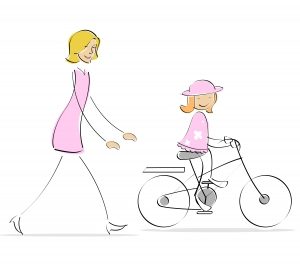
That feeling of control does that.
“Only you can control your future.”
-Dr. Seuss
I was at a school, recently, leading a therapeutic drum circle for a class of children with disabilities. The students each had a developmental disability, although I didn’t always know what that disability was.
I went around the circle, asking the kids what they did over the weekend. I would then incorporate the activity with the child’s name into a drumbeat that we could all play and say. It is a blast and they love it. It’s a real confidence builder!
One girl in the class, we’ll call her Tammy, has cerebral palsy. She can’t speak clearly and lacks control of her limbs. Her abilities are hampered to a point that she is in a power wheelchair.
 I make it a priority to get kids involved that may not be able to participate in activities in a traditional way. I decided to try a couple of items on Tammy’s wrists – a wristband with an egg shaker attached (which I made) and a set of wrist bells that I had purchased.
I make it a priority to get kids involved that may not be able to participate in activities in a traditional way. I decided to try a couple of items on Tammy’s wrists – a wristband with an egg shaker attached (which I made) and a set of wrist bells that I had purchased.
“Let the child be the scriptwriter, the director, and the actor in his own play.”
-Magda Gerber
The idea was that by even moving her arms a little bit, she would be making music and participating like everyone else.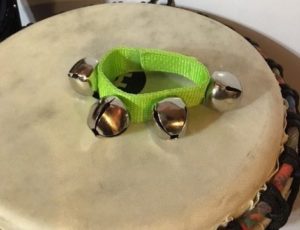
She lit up when I did this. By having the ability to play along with the group, she became one of us. I would get information from her about her favorite things or recent activities and we would all create music based on that.
Tammy was all smiles and laughing uncontrollably at times. Her teachers and aides were taking pictures with her and she would give them big hugs. It’s amazing to see the happiness that giving someone that little bit of control can make.
She was one of us. She was no longer classified by the things she could and could not do but recognized for the contributions she made to the session!
Thinking outside of the box, just a little bit, allowed Tammy to become a participant instead of an observer. Giving her control of her participation in an activity that is fun and invigorating taught us all that changing just a small part of the game made participation for everyone not only possible – but natural.
If you would like to learn more and get some free resources, you can do so by clicking here.
Fun, Favorable, AND Frugal Activity?!
Remember growing up – when you had to be creative and make the presents for your family? Maybe it was just me, but I often made pencil holders out of soup cans and construction paper.
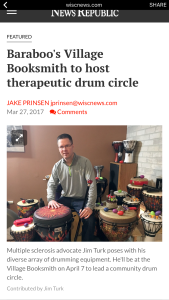
It seemed hokey but it was creative and from me. That is what the holidays are about!
Nothing is worse than not having the resources to give what you think is deserving of the people you care for. Especially when those people are dependent on you! You feel like you’re doing them a disservice.
When we think about activities that we can do with residents, music therapy is high on the list but generally costs quite a bit and the frequency is too low to really make a difference. Group drumming is in that family but also can be inhibitory from a cost standpoint.
“Music washes away the dust of every day life.”
-Art Blakey
Drumming is a blast and anyone, regardless of ability, can do it. It is scientifically proven to be a huge benefit to all kinds of people. Assisted living and nursing home residents are high on the list. The problem is that you need the equipment as well as someone to lead the group.
Well, you can get by without that expensive stuff! You can even have newbies and volunteers lead it if you’re short-staffed!
There are free audio group drumming sessions on this webpage: Click Here. It even includes a video on making your own instruments as well as links to buy inexpensive ones if you choose to do that (eventually).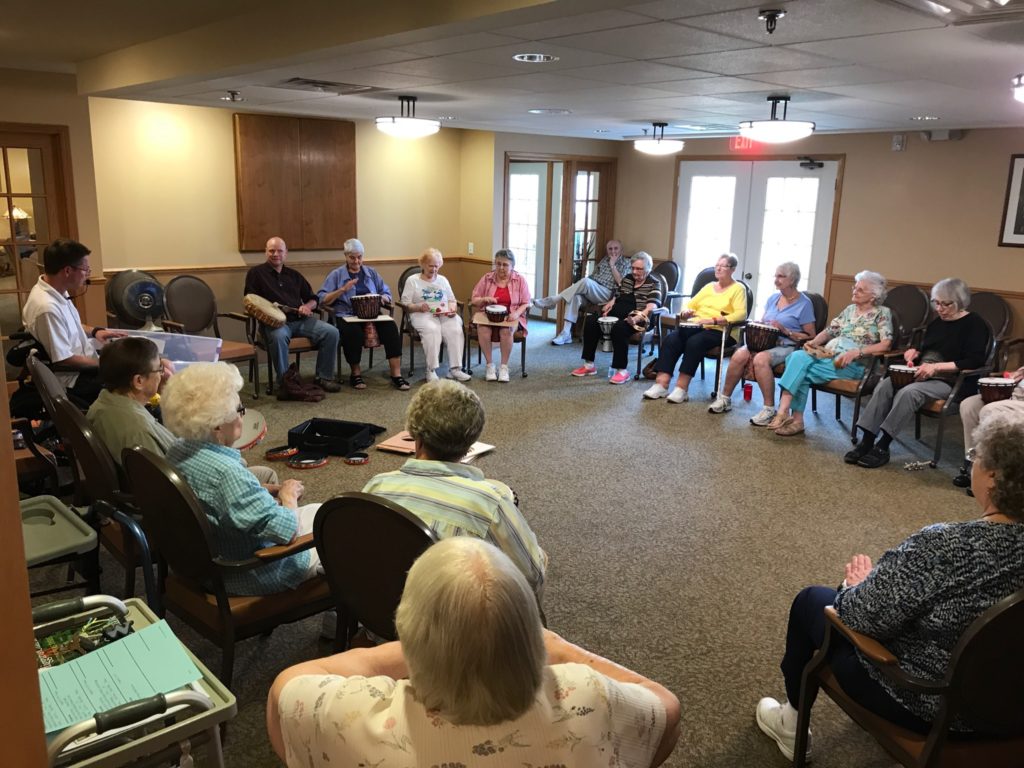
“There are 106 miles to Chicago. We have a full tank of gas, half a pack of cigarettes, it’s dark, and we’re wearing sunglasses. ”
-Elwood Blues
No matter your situation, you can make this work. I regularly lead groups of kids, adults with disabilities, seniors, and more! There are plenty of free programs included on the page.
I SAID FREE!
They’ll get you started and you can decide if you want to buy the 50+ audio tracks at a special rate. For December, I’ve decided to give everyone a holiday gift. I know, I am like a modern day Robin Hood 🤠.
I am including a whole DIY program for conducting drum circles on your own. This includes words and phrases (I use language rather than written music to make it easy to play) that you can use, demonstration videos, games you can play, plans that you can use without preparing, and much more. Normally, they go for $197 each but for the rest of the month you get them both for $97!
“Are you not entertained?”
– Maximus Decimus Meridius
It really is of huge benefit to everyone. They love it and you’ll love it! Check out all of the free sessions and see for yourself. Good luck!
You Can Make a Nothing Day All Seem Worth While!
Don’t Let the Perfect be the Enemy of the Good
Have you ever heard the expression don’t let the perfect be the enemy of the good? Are you better than the math teacher when you help your kids with their homework? Is a tennis coach better than the player – no!
Perfection is different than explaining, guiding, and assisting. It’s not being “the best” but I’ve noticed that people who have made it their mission to help others and make their lives better are sometimes afraid to tackle somethiing when they’re not “perfect” at it.
Drum therapy does a lot for people of all ages and especially for people living in retirement, assisted living, and nursing homes, with PTSD sufferers, and people with a whole slew of diseases. A major stumbling block, though, is that activity directors, CNAs, therapists, caregivers, and volunteers, won’t do it themselves and make their only option to bring in a professional.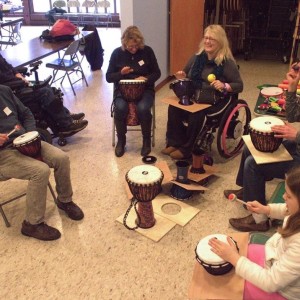
Maybe they should!
“Maybe my best isn’t as good as someone else’s, but for a lot of people, my best is enough.”
-Lindsey Stirling
While bringing someone in is a big step towards providing residents with a better quality of life and is great fun to do on occasion, there are many logistical concerns that may make it impractical.
- This is a therapy that can only be provided by a professional on an infrequent basis if at all.
- Some facilities are located in an area that doesn’t have access to this type of therapy.
- Most other places can’t afford to bring somebody in with their equipment often enough to see the long-term benefits that research illustrates.
Benefits
Scientific research has illustrated many points that are associated with group drum therapy. This includes many physical, mental, and social benefits.
But there is another advantage that gets less attention. Did you know that drumming actually synchronizes the two hemispheres of the brain?
Drumming is one of the few activities that uses both the creative side AND the logical side 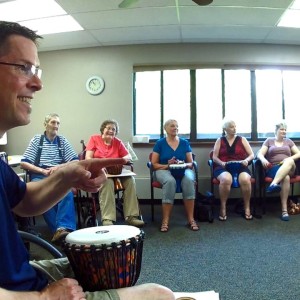 of the brain. This can actually lead to getting better sleep, being more creative, improved immunity, enhanced mental processing, reduced stress, less fatigue, and potential reduction and addictive tendencies.
of the brain. This can actually lead to getting better sleep, being more creative, improved immunity, enhanced mental processing, reduced stress, less fatigue, and potential reduction and addictive tendencies.
If you were to see even half of those changes in your residents, wouldn’t that be awesome?!
And this doesn’t even account for the advantages that aren’t accounted for. Advantages like increasing range of motion and functionality, the feeling of being young again (fun, invigorating, and contemplative), and energizing. Why would you ever deprive your residents of this in their golden years?
“That was one of the most exciting programs I’ve experienced in a very long time. So entertaining and instructive and creative…..not enough words to describe”
-email from a resident at one of my recent sessions
Isn’t a Better Quality of Life in Everybody’s Best Interest?
I started by saying don’t let the perfect be the enemy of the good. This is something I feel strongly about. It’s great to be able to bring in someone to perform this activity but we need to be realistic.
Remember that leading people, if you have some basic tools, is not only easy – but it can and will bring you closer together as you work through activities that are best for your particular group!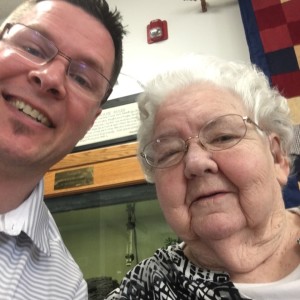
There is a whole set of videos (including how to make easy instruments and links to cheap ones), instructions, and easy-to-follow plans (like I use) for leading drum circles (group drumming) with your patients Here. It’s tons of fun, therapeutic, and it makes you more marketable!
“Never had one lesson!”
-Ferris Bueller
I spend a lot of time providing group drum therapy for others. I love it and they love it. I can only get to a place so often, though.
If you can do it every day, see the smiles on their faces, and feel the advantages that research (which is performed in a short amount of time on a very regular and consistent basis – that’s how research is done), why wouldn’t you?
Raise Resident Quality of Life and Save Money at the Same Time
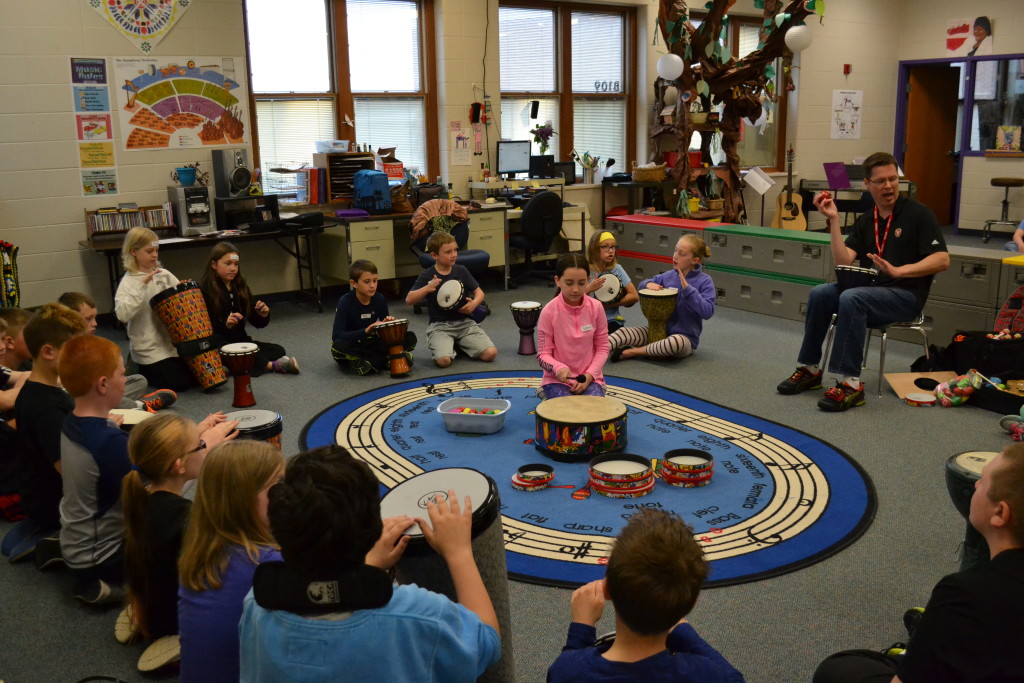 Have you ever been in a situation where you wake up at three in the morning and an idea comes to you that’s so obvious, so simple, that you can’t believe it didn’t occur to you before.
Have you ever been in a situation where you wake up at three in the morning and an idea comes to you that’s so obvious, so simple, that you can’t believe it didn’t occur to you before.
This happened to me with group drum therapy. As a person that visits a lot of nursing homes and assisted living homes to perform this kind of activity, I assumed that you needed all of the correct experience and knowledge in order to do it.
But what I found was that I had a better experience when the therapist or other attendant was walking around helping me out. It occurred to me that in order to get the best, most therapeutic, and most fun results for the residents, the therapists or attendants needed to be involved.
They’re the experts. They have the knowledge of and the relationships and rapport with 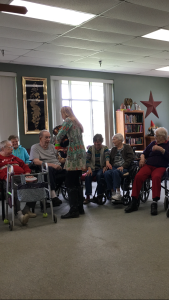 the residents. More than that – they can do this every day, if they want.
the residents. More than that – they can do this every day, if they want.
I know they probably wouldn’t, but a lot of the value comes from frequency – as you do it more, the participants get more comfortable with the idea and become more creative – and more active! There’s a better chance that they’ll remember what you did the time before. There is a lot of value in making this a regular part of your routine.
So why do I need to be there? I know that people respond better to a new face and somebody that they can associate with only that activity. The reality is, though, that I can only get to a certain facility every month or so and that’s all they can afford!
It’s really just a matter of having the tools. If members of the staff or volunteers know how to perform the sessions, they can do this all of the time and have an effective way not only for the residents to enjoy themselves but also to stimulate physical, mental, and social activities.
They don’t need to understand music theory and have the ability to play a song on the guitar! Don’t get me wrong – there’s value in that and I have a great deal of respect for the therapists that do that. They don’t have to, though. Don’t let the perfect be the enemy of the good. There is tremendous value in group drumming and it is not the same thing as music therapy.
Group drumming (e.g. a drum circle) is a scientifically proven but underutilized therapy and a very effective way to play games, review trivia, and do just about anything else you want – and creating the instruments, decorating, and personalizing them, can be a separate activity that can be repeated, all in itself!
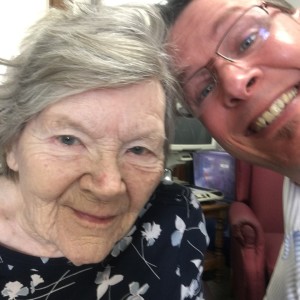 The best part, though, is that it’s free (once someone is trained). When your volunteers conduct the activity, the residence will get as much if not more out of each session and it’s an easy enrichment activity to do when nothing else is booked or planned!
The best part, though, is that it’s free (once someone is trained). When your volunteers conduct the activity, the residence will get as much if not more out of each session and it’s an easy enrichment activity to do when nothing else is booked or planned!
At a time when budgets are tight and money is shifted away from activities and enrichment, this is a great way to raise the quality of life of residence while saving money.
If you’re interested in leading drum therapy at your facility – this will get you started: http://beatmydisease.com/bmd-drum-circle-1/
Madison Man Living with MS Set for Eighth Walk MS
Jim Turk, a native of Madison, holds a bachelor’s degree in Natural Science and a master’s degree in 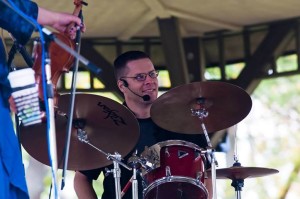 biotechnology, from the University of Wisconsin-Madison, is a husband and father of two sons, a blogger, an avid drummer…and has been living with multiple sclerosis since 2008.
biotechnology, from the University of Wisconsin-Madison, is a husband and father of two sons, a blogger, an avid drummer…and has been living with multiple sclerosis since 2008.
MS is an unpredictable, often disabling disease of the central nervous system. There is no known cause, or cure.
“My neurologist has said that this is what makes me unique – high-level research knowledge but with the patient perspective,” Jim says in his blog. “I wasn’t going to take this diagnosis lying down!”
On May 7, 2017, Jim and his team MS for MS will join more than 1,200 people at Walk MS: Madison to raise more than $185,000 to fund the Society’s critical research. Since 2009, Jim has volunteered and co-chaired the Walk in Madison.
“I used my training and research knowledge to tackle living with MS,” he says. “I’m in a much better place than I was before this came about, I’ve figured out how to achieve balance in my life, and not a day goes by without me continuing to work on it.”
 Balance issues, related to MS, have Jim using a wheelchair to move around safely. Yet, he exemplifies standing in defiance of a disease that’s trying to stop people from moving. He remains active by presenting at grade schools and colleges about living with MS, has attended several meetings and conferences on behalf of the Society, and shares his passion for drumming as much as possible.
Balance issues, related to MS, have Jim using a wheelchair to move around safely. Yet, he exemplifies standing in defiance of a disease that’s trying to stop people from moving. He remains active by presenting at grade schools and colleges about living with MS, has attended several meetings and conferences on behalf of the Society, and shares his passion for drumming as much as possible.
“I have a real passion in bringing joy to others while raising awareness for the disease.”
Walk MS is an opportunity for people living with MS and those who care about them to connect, join together, and be inspired. In 2016 alone, nearly 300,000 people at more than 550 locations across the country walked to create a world free of MS, raising nearly $50 million.


 The Amazing Rewards
The Amazing Rewards